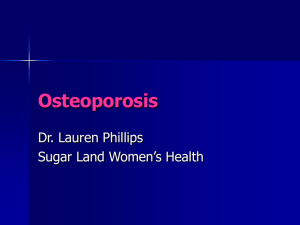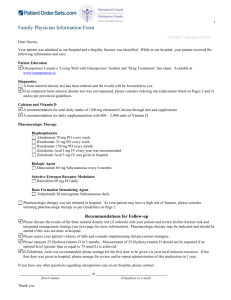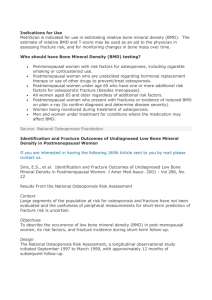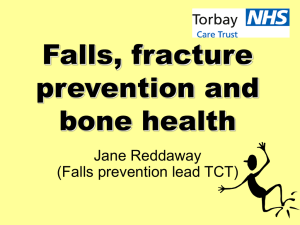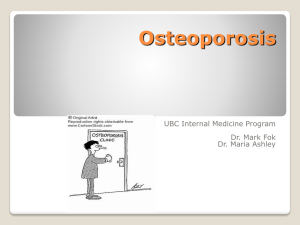Diseases of Bone Osteoporosis
advertisement
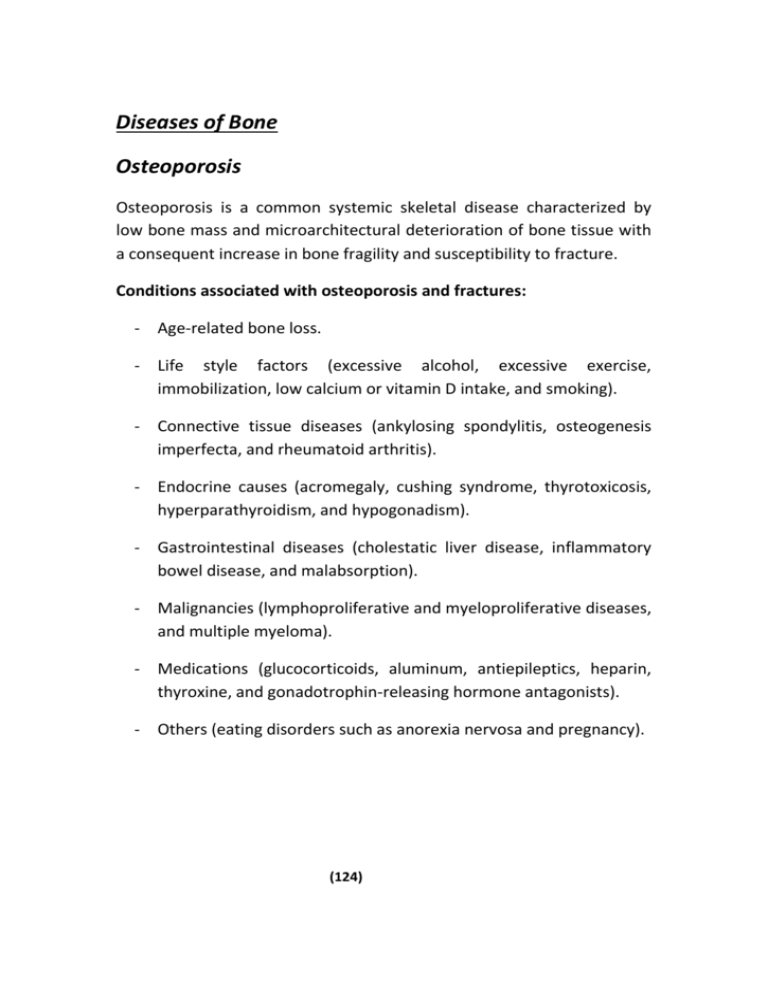
Diseases of Bone Osteoporosis Osteoporosis is a common systemic skeletal disease characterized by low bone mass and microarchitectural deterioration of bone tissue with a consequent increase in bone fragility and susceptibility to fracture. Conditions associated with osteoporosis and fractures: - Age-related bone loss. - Life style factors (excessive alcohol, excessive exercise, immobilization, low calcium or vitamin D intake, and smoking). - Connective tissue diseases (ankylosing spondylitis, osteogenesis imperfecta, and rheumatoid arthritis). - Endocrine causes (acromegaly, cushing syndrome, thyrotoxicosis, hyperparathyroidism, and hypogonadism). - Gastrointestinal diseases (cholestatic liver disease, inflammatory bowel disease, and malabsorption). - Malignancies (lymphoproliferative and myeloproliferative diseases, and multiple myeloma). - Medications (glucocorticoids, aluminum, antiepileptics, heparin, thyroxine, and gonadotrophin-releasing hormone antagonists). - Others (eating disorders such as anorexia nervosa and pregnancy). (124) Clinical Features History: - Identification of family history of metabolic bone disease, life style factors, history of previous fractures, reproductive history, endocrine history, dietary factors, smoking history, alcohol intake, exercise, past and current medications. - Identification of factors that increase the risk of falls (such neuromuscular diseases and unsafe living conditions). - History of bone pain is useful (however, osteoporosis is not painful unless fractures develop). - Common sites of osteoporosis fractures include forearm (Colle's fracture), spine (vertebral fracture), and femur (hip fracture). Physical Examination: - Height at each visit (loss of 2 inches is a fair sensitive indicator of vertebral compression fracture). - Spine should be examined for conformation, and spinal and paraspinal tenderness. If kyphosis is present, the possibility of pulmonary compromise should be considered. - Signs of secondary causes. - Neurological examination for muscle weakness predisposes to fall. - Gynecological examination should be included if hormone replacement therapy is considered. (125) Investigations Laboratory Evaluation: - Seek for possible causes of secondary loss of bone mineral density, e.g. serum protein electrophoresis and complete blood count for multiple myeloma; serum calcium, phosphorus, and parathyroid hormone for hyperthyroidism; 24-hour urine free cortisol for Cushing syndrome; thyroid stimulating hormone for hyperthyroidism; and follicle stimulating hormone for menopause. - In osteoporosis in men and premenopausal women, investigate for hypogonadism (sex hormones and gonadotrophins). - In postmenopausal osteoporosis, biochemistry is normal, but serum alkaline phosphatase can be raised transiently following a fracture. Imaging: 1- Conventional radiography is useful, both by itself and in conjunction with CT or MRI, for detecting complications of osteopenia (reduced bone mass; preosteoporosis), such as fractures; for differential diagnosis of osteopenia; or for follow-up examinations in specific clinical settings, such as soft tissue calcifications, secondary hyperparathyroidism, or osteomalacia in renal osteodystrophy. However, radiography is relatively insensitive to detection of early disease and requires a substantial amount of bone loss (about 30%) to be apparent on X-ray images. 2- Dual-energy x-ray absorptiometry (DXA) is currently the gold standard for diagnosis and follow up of osteoporosis. DXA typically measures bone density in the hip, the spine, and the forearm. The test takes only five to 15 minutes to perform, exposes patients to very little radiation Bone mass is reported as an absolute value in g/cm an, and a comparison to mean bone mass of young adult normal individuals (T score).T scores are used to predict fracture risk and classify disease status. DXA measures bone mass at central and peripheral sites. The International Society for Clinical Densitometry takes the position that a diagnosis of osteoporosis in men under 50 years of age should not be made on the basis of densitometric criteria alone. It also states, for premenopausal women, Z-scores (comparison with age group rather than peak bone mass) rather than T-scores should be used, and the diagnosis of osteoporosis in such women also should not be made on the basis of densitometric criteria alone. DXA bone densitometry is a simple, quick and noninvasive procedure. No anesthesia is required. the amount of radiation used is extremely small, and less than a day's exposure to natural radiation. The radiation received by the patient during the scan is less than that of an airline flight from California to New York and back ,so it was safe & did not need for lead protection. 3- Quantitative ultrasound (QUS) measures bone mass at peripheral sites, and used as a screening tool for osteoporosis . (126) Diagnosis WHO Criteria for the Diagnosis of Osteopenic Bone Disease Based Upon T-Score 1. Normal: bone mineral density (BMD) not more than 1 SD below peak adult bone mass (T score > - 1) 2. Osteopenia: BMD that lies between 1 and 2.5 SD below peak adult bone mass (T score between – 1 and – 2.5) 3. Osteoporosis: BMD value more than 2.5 SD below peak adult bone mass (T score less than or equal to – 2.5) 4. Severe osteoporosis: BMD criteria for osteoporosis and the presence of one or more fragility fractures Prevention and Treatment Life Style Issues Important for Prevention & Treatment of Osteoporosis - Calcium: recommended intake is 1200 mg daily for adults over age 50. Calcium carbonate is effective. Calcium citrate is better tolerated for patients who have digestive distress. - Vitamin D: the recommended intake is 400 to 800 IU daily. - Exercise: Weight-bearing exercise: Walking at least 40 minutes a session, at least 4 sessions a week. Spinal strengthening exercises are also advisable. - Avoid cigarette smoking and high intake of caffeine. (127) Pharmacologic Agents Indications: 1. Women who have T scores of -2.5 and below. 2. Women with risk factors whose T scores are -1.5 or below. Advantages: 1. Reduce the risk of fracture in women who had a fracture. 2. Reduce the risk of fracture in women who have low bone mineral density (T scores -2.5 and below). 3. Prevent bone loss in women who have recently begun menopause. Medications employed to treat osteoporosis include: - Bisphosphonates (alendronate 10 mg/day or 70 mg once weekly for treatment, and 5 mg/day or 35 mg once weekly for prevention of osteoporosis) for up to 3-5 years. Other bisphosphonates approved by FDA also like: Risedronate 35 mg/week, ibandronate 150mg/month & zoledronic acide( i.v. infusion) annually . - Nasal calcitonin 200 IU (one spray) daily for acute painful vertebral fractures. - Estrogen for relief of menopausal symptoms for the shortest period of time. - Raloxifene 60 mg/day for prevention of bone loss in recently menopausal women and for treatment of established osteoporosis. - Teriparatide (1-34 recombinant human parathyroid hormone) 20 mcg subcutaneously daily is reserved for patients at very high risk of fracture or patients who seem to be failing other therapies. Teriparatide is the only osteoporosis medication that has the potential to rebuild bone and actually reverse osteoporosis, at least somewhat. - Denosumab is a newer medication shown to reduce the risk of osteoporotic fracture in women and men. Unrelated to bisphosphonates, denosumab might be used in people who can't take a bisphosphonate, such as some people with reduced kidney function. (128) Guideline for Osteoporosis Prevention and Treatment 1. Normal (T score > - 1) Reassurance 2. Mild osteopenia (T score - 1 to - 2) Advice on life style factors (stop smoking, limit alcohol, dietary calcium intake of 1500 mg daily, and encourage exercise) Reassess after 3-5 years 3. More severe osteopenia (T score - 2 to - 2.5) and osteoporosis (T score - 2.5 and below) Life style advice Drug treatment 4. Osteoporosis + fragile fracture Drug treatment is strongly indicated, since their risk of further fracture is high Monitoring Therapy - The response to treatment is monitored by repeating spine BMD measurement, between 12-24 months after starting therapy. - Increases in BMD of 5-8% are expected with hormone replacement therapy and bisphosphonates. - If BMD measurements are not available, then progression of spinal osteoporosis can be monitored by changes in height. - The development of fracture during treatment is not a reason for stopping treatment, since even the most potent agents only reduce the risk of fracture by 50%.
